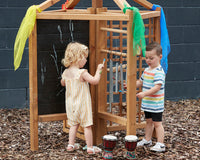Choosing the right instruments for the classroom is a crucial part of encouraging curricular and extra-curricular music within a school. With
guitars for education specifically, factors such as ease-of-use, versatility, and playability all create appeal - or don’t! As such, these are really important elements to consider when selecting your school’s guitar choices. Here’s an overview of what to consider when stocking your music department with guitars:
Size Guide
The key thing here is, what ages will the students/pupils playing these guitars be? The size guide below shows an estimate of age/guitar size required:

Keep in mind that this is just a guide. Just as children of the same age vary in size, one full size guitar may feel much larger than another. When choosing guitars for education, a school will often go down the middle and stock up on 3/4 size guitars, because whilst they tend to be just about accessible to all but the youngest beginners, they’re also playable by students aged 11+, in a way that 1/2 size guitars sometimes are not, being simply too small to play comfortably. The
Yamaha JR1 is a great choice of 3/4 size guitar.
Type & Accessibility
What is meant by 'type' is essentially acoustic, classical, or electric (and even perhaps bass guitars, banjos, mandolins, ukuleles etc if your school is eclectic and ensemble-focused). Although it’s fantastic for schools to equip students with the chance to play electric guitars, typically a music department will focus on acoustic or classical guitars, for various reasons:
- They’re quieter and less potentially disruptive to classes/other music students.
- They’re more portable and accessible as they do not require amplifiers/cables etc.
- They tend to appeal more to parents, who often want their children to begin with acoustic or classical guitar, before progressing to electric.

The main difference between an acoustic and classical guitar relates to the strings. An
acoustic will typically have steel strings, whereas a
classical will have nylon. Otherwise, there’s not too much difference, meaning that - at least for practice’s sake - they can be interchangeable. For this reason, it makes sense to buy classical guitars, such as the
3rd Avenue Classical Guitar Pack, because the softer aesthetic of the nylon strings will make a smoother, more painless entry to guitar playing for the young players in question.
Suitable Price
The price is always a big factor in any instrument purchase. For most, it’s all about finding a balance and a trade-off between price and quality. You want to spend enough to buy a quality instrument, but not spend unnecessarily. Particularly if it’s a beginner’s instrument, or for multiple students to use as school purchases tend to be. The key thing to consider here is how many guitars do you need? This will likely depend on the size of your music department, and what the guitars’ intended use will be. Is it better to have 12 average guitars than 4 really good ones? And so on. These are questions you’ll need to consider based on your own circumstances. The point is that it’s good to establish a spectrum of options within a range. You can then make a comparative decision.

For example, looking at 3/4 size
electric guitar ‘starter packs’ (containing the amplifier and accessories that an electric guitar uniquely requires), there’s the
3rd Avenue Starter Pack at around £150, but then there’s also the
Squier by Fender Strat Pack at around £200. Your music department would need to decide if it's better serviced by 10 of the former, or 4 of the latter. But it’s important to establish and consider these kinds of options.
Guitar's Appeal
Considering a guitar’s appeal based on its look, colour, and style may feel a somewhat minor concern compared to the other points above. However, these things can be huge factors in creating an initial spark of interest in children, who then hopefully go on to have fun and make progress playing the instrument and enjoy it for what it is. However, something as simple as a brightly coloured guitar can go a very long way in inspiring a child to just pick up the instrument in the first place.

For this reason, if all other factors are equal, it’s worth considering something like this beautiful
3rd Avenue Blueburst Classical Guitar over a natural equivalent. Of course, as above, this is always going to be a secondary concern when choosing guitars for education, but it really can make a difference!

 Keep in mind that this is just a guide. Just as children of the same age vary in size, one full size guitar may feel much larger than another. When choosing guitars for education, a school will often go down the middle and stock up on 3/4 size guitars, because whilst they tend to be just about accessible to all but the youngest beginners, they’re also playable by students aged 11+, in a way that 1/2 size guitars sometimes are not, being simply too small to play comfortably. The Yamaha JR1 is a great choice of 3/4 size guitar.
Keep in mind that this is just a guide. Just as children of the same age vary in size, one full size guitar may feel much larger than another. When choosing guitars for education, a school will often go down the middle and stock up on 3/4 size guitars, because whilst they tend to be just about accessible to all but the youngest beginners, they’re also playable by students aged 11+, in a way that 1/2 size guitars sometimes are not, being simply too small to play comfortably. The Yamaha JR1 is a great choice of 3/4 size guitar.
 The main difference between an acoustic and classical guitar relates to the strings. An acoustic will typically have steel strings, whereas a classical will have nylon. Otherwise, there’s not too much difference, meaning that - at least for practice’s sake - they can be interchangeable. For this reason, it makes sense to buy classical guitars, such as the 3rd Avenue Classical Guitar Pack, because the softer aesthetic of the nylon strings will make a smoother, more painless entry to guitar playing for the young players in question.
The main difference between an acoustic and classical guitar relates to the strings. An acoustic will typically have steel strings, whereas a classical will have nylon. Otherwise, there’s not too much difference, meaning that - at least for practice’s sake - they can be interchangeable. For this reason, it makes sense to buy classical guitars, such as the 3rd Avenue Classical Guitar Pack, because the softer aesthetic of the nylon strings will make a smoother, more painless entry to guitar playing for the young players in question.
 For example, looking at 3/4 size electric guitar ‘starter packs’ (containing the amplifier and accessories that an electric guitar uniquely requires), there’s the 3rd Avenue Starter Pack at around £150, but then there’s also the Squier by Fender Strat Pack at around £200. Your music department would need to decide if it's better serviced by 10 of the former, or 4 of the latter. But it’s important to establish and consider these kinds of options.
For example, looking at 3/4 size electric guitar ‘starter packs’ (containing the amplifier and accessories that an electric guitar uniquely requires), there’s the 3rd Avenue Starter Pack at around £150, but then there’s also the Squier by Fender Strat Pack at around £200. Your music department would need to decide if it's better serviced by 10 of the former, or 4 of the latter. But it’s important to establish and consider these kinds of options.
 For this reason, if all other factors are equal, it’s worth considering something like this beautiful 3rd Avenue Blueburst Classical Guitar over a natural equivalent. Of course, as above, this is always going to be a secondary concern when choosing guitars for education, but it really can make a difference!
For this reason, if all other factors are equal, it’s worth considering something like this beautiful 3rd Avenue Blueburst Classical Guitar over a natural equivalent. Of course, as above, this is always going to be a secondary concern when choosing guitars for education, but it really can make a difference! 




















